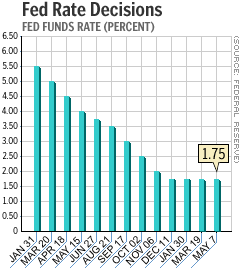
NEW YORK (CNN/Money) -
The Federal Reserve left a key interest rate unchanged Tuesday and said the risks to the U.S. economy were evenly balanced between a risk of economic weakness and a risk of inflation.
As expected, Fed policy makers decided to leave their target for the federal funds rate, an overnight bank lending rate, unchanged at 1.75 percent, the lowest level in 40 years.
"This is not much of a surprise," Bank One chief economist Diane Swonk told CNNfn's Money Gang program. "We've got a Fed saying growth is strong, but they're still hedging against a downturn. This is a Fed waiting to see the whites of the eyes of recovery."
Fed policy makers, which next meet on June 25-26, also left the largely symbolic discount rate unchanged at 1.25 percent.
The fed funds rate forms the basis for banks' prime lending rates and affects the cost of borrowing for consumers and businesses. Plunging short-term rates last year led to a surge in refinancing and eventually brought mortgage rates lower, fueling a red-hot housing market.

Low rates also probably helped make the latest economic recession, which likely began in March 2001, among the shortest and mildest in history, keeping consumers spending despite terror attacks, rising unemployment, falling stock prices and other shocks.
In the closely watched statement accompanying its decision, the Fed said that the end of last year's massive business inventory sell-off had lifted the economy so far this year, but the strength of final demand -- necessary to justify an increase in production -- was still uncertain.
The Fed also said its decision to leave rates alone was unanimous, the first time it had revealed how policy makers voted on the same day of its policy announcement.
U.S. stock prices gave up some of their earlier gains after the announcement, while Treasury bond prices were mixed.
The Fed cut rates 11 times in 2001, a record for a calendar year. It has left rates unchanged after three meetings so far in 2002, and a growing number of economists think rates could be low for much of the year.
One thing staying the Fed's hand is a growing unemployment rate, which jumped to 6 percent in April -- a report that erased any doubt the Fed would leave rates alone -- and could cool consumer spending, which fuels two-thirds of the U.S. economy.
"If the unemployment rate rises through July, as is entirely possible, the initial tightening will take place during the fall," said Merrill Lynch chief economist Bruce Steinberg.
So far, a majority of economists think the Fed is likely to start raising rates at its August meeting. But it's impossible to know if the Fed will have enough information by that time to make a move.
Inflation still a distant threat
Though the Fed said the current low level of short-term rates is "accommodative," meaning it's more suitable for fighting economic weakness than inflation, prices have been low for some time, and most economists are not currently worried about inflation.
Tuesday morning's report on first-quarter productivity, which showed the strongest gain in nearly 19 years, also pointed to lower inflation, since productivity allows the economy and corporate profits to grow without raising costs.
"The stronger [the] productivity, the more likely profit margins are to widen, and [there's] less inflation pressure," Steinberg said.
On the other hand, much of the gain in productivity has come at the expense of workers, and companies could be unlikely to hire new workers until they're sure the economy is recovering enough to spur demand for their products.
Until much of this uncertainty is removed, the Fed is unlikely to raise interest rates and risk hurting the recovery, many economists believe.
| |
 Related links
Related links
| |
| | |
| | |
|
"The Fed needs firm evidence that the tire has hit the ground and that we're really moving forward in a very firm way," Swonk said. "They're going to wait to see second quarter GDP [gross domestic product] and more evidence that business investment and equipment spending, especially in IT [information technology] is firm before they move to start normalizing rates."
GDP growth, the broadest measure of economic strength, jumped to a 5.8 percent annual rate in the first quarter after a negative third quarter and an anemic fourth quarter.
But most of that dramatic gain was a reflection of how businesses handled their inventories. Though they fell by $36 billion in the quarter, that was a far cry from the record $119-billion drop in the prior quarter, and the big difference was counted by the government as GDP growth.

|

